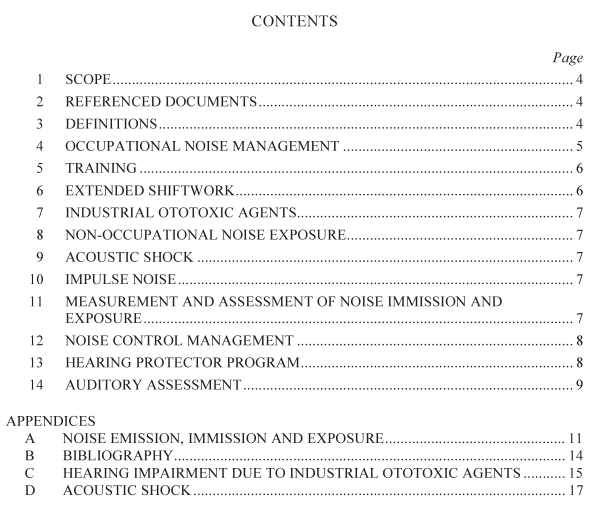AS NZS 1269.0 pdf download – Occupational noise management Part 0: Overview and general requirements

AS NZS 1269.0 pdf download – Occupational noise management Part 0: Overview and general requirements
7 INDUSTRIAL OTOTOXIC AGENTS Workplaces may also contain ototoxic agents. Ototoxic agents are chemical substances that have a detrimental effect on an individual’s hearing. Threshold shifts produced by these agents may compound those produced by excessive noise exposure. NOTE: See Appendix C for a list of implicated substances and further explanation.
8 NON-OCCUPATIONAL NOISE EXPOSURE People who have significant occupational noise exposure should be informed that noise exposures are cumulative and that it is in their interest to limit noise exposure and wear hearing protectors when exposed to noise outside working hours, as well as at work. 9 ACOUSTIC SHOCK Over the last few years in workplaces where there is constant use of telephones, particularly is such places as the call centre industry, the phenomena of acoustic shock has been on the increase. While acoustic shock is not strictly a noise exposure problem, improved workplace acoustic conditions and suppression of telephone noises via an Acoustic Shock Protective Device are part of an acoustic shock preventative program.
NOTE: More details are provided in Appendix D.
10 IMPULSE NOISE Impulse noise is noise that consists of a distinct single pressure peak, a sequence of single peaks, a single burst with multiple pressure peaks or a sequence of such bursts. Impulse noise may be the only noise present or may be superimposed on a background of a continuous noise. Impulse noise presents an additional noise hazard in that, if the peak level is sufficiently high an instantaneous injury may result.
11 MEASUREMENT AND ASSESSMENT OF NOISE IMMISSION AND EXPOSURE AS/NZS 1269.1 describes the types of noise assessments which may be required and suitable noise measuring instruments to carry them out. The procedures for noise measurement are also included. The general objectives of these assessments are as follows:
(a) To determine the exposure to noise of all people likely to be exposed to excessive noise. For the purpose of AS/NZS 1269.1, the exposure to noise of each person is established in terms of—
(i) eight-hour equivalent continuous A-weighted sound pressure level (L Aeq,8h ) or A-weighted noise exposure (E A,T ); and (ii) the peak sound pressure level (L peak , L C,peak ). Exposure to noise is taken to be that determined at the person’s ear position without taking into account any protection which may be afforded by personal hearing protectors.
(b) To obtain more specific information that will help senior management decide what measures to take to reduce noise.
(c) To check the effectiveness of any control measures which have been applied.
(d) To assist in the selection of appropriate hearing protectors where other control measures are not practicable, or will take some time to plan and implement. The type and detail of assessments carried out will depend on the use that is to be made of the information obtained.
The type of measuring instruments and procedures to be used for the measurement of noise levels will depend on such factors as the type of workplace, type of noise, work patterns and information required.
12 NOISE CONTROL MANAGEMENT
12.1 General AS/NZS 1269.2 outlines noise control management strategies that should be implemented in both existing and proposed workplaces. AS/NZS 1269.2 is applicable to all workplaces and all types of noise, including those produced by human activity.
12.2 Strategies for noise control management Noise control management strategies should recognize that—
(a) noise control is the most effective method of preventing noise injury in the workplace;
(b) engineering noise controls are preferred over administrative controls;
(c) employees and supervisors should be fully informed about noise problems and involved in the development of solutions; and
(d) expert advice should be sought when dealing with technically complex situations.









